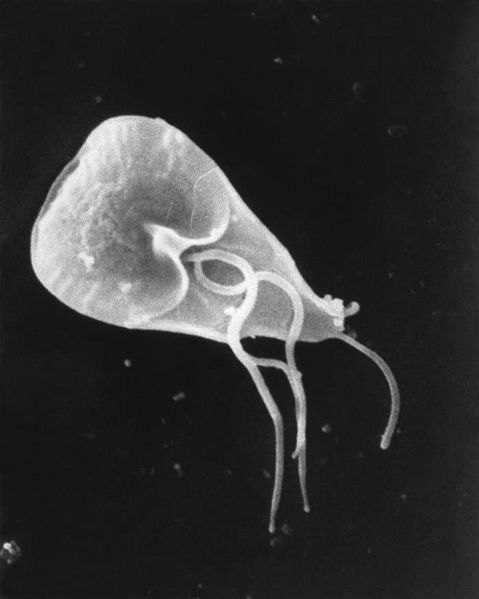Giardiasis: Difference between revisions
No edit summary |
m (Robot: Automated text replacement (-{{SIB}} + & -{{EH}} + & -{{EJ}} + & -{{Editor Help}} + & -{{Editor Join}} +)) |
||
| Line 19: | Line 19: | ||
{{CMG}} | {{CMG}} | ||
==Overview== | ==Overview== | ||
| Line 51: | Line 51: | ||
[[Category:Infectious disease]] | [[Category:Infectious disease]] | ||
{{WikiDoc Help Menu}} | {{WikiDoc Help Menu}} | ||
{{WikiDoc Sources}} | {{WikiDoc Sources}} | ||
Revision as of 15:31, 9 August 2012
| Giardiasis | |
 | |
|---|---|
| Giardia cell, SEM | |
| ICD-10 | A07.1 |
| ICD-9 | 007.1 |
| DiseasesDB | 5213 |
| MedlinePlus | 000288 |
| eMedicine | emerg/215 |
| MeSH | D005873 |
|
WikiDoc Resources for Giardiasis |
|
Articles |
|---|
|
Most recent articles on Giardiasis |
|
Media |
|
Evidence Based Medicine |
|
Clinical Trials |
|
Ongoing Trials on Giardiasis at Clinical Trials.gov Clinical Trials on Giardiasis at Google
|
|
Guidelines / Policies / Govt |
|
US National Guidelines Clearinghouse on Giardiasis
|
|
Books |
|
News |
|
Commentary |
|
Definitions |
|
Patient Resources / Community |
|
Patient resources on Giardiasis Discussion groups on Giardiasis Patient Handouts on Giardiasis Directions to Hospitals Treating Giardiasis Risk calculators and risk factors for Giardiasis
|
|
Healthcare Provider Resources |
|
Causes & Risk Factors for Giardiasis |
|
Continuing Medical Education (CME) |
|
International |
|
|
|
Business |
|
Experimental / Informatics |
For the WikiPatient page for this topic, click here
Editor-In-Chief: C. Michael Gibson, M.S., M.D. [1]
Overview
Giardiasis (also known as beaver fever) is a disease caused by the flagellate protozoan Giardia lamblia (also sometimes called Giardia intestinalis and Giardia duodenalis) [1]. The giardia organism inhabits the digestive tract of a wide variety of domestic and wild animal species, including humans. It is a common cause of gastroenteritis in humans, infecting approximately 200 million people worldwide.
Transmission
Giardiasis is passed via the fecal-oral route. Primary routes are personal contact and contaminated water and food. People who spend time in institutional or day-care environments are more susceptible, as are travelers and those who consume improperly treated water. It is a particular danger to people hiking or backpacking in wilderness areas worldwide. Giardia is suspected to be zoonotic—communicable between animals and humans. Major reservoir hosts would include beavers, dogs, cats, horses, and cattle.
Symptoms
Symptoms include loss of appetite, lethargy, fever, explosive diarrhea, loose or watery stool, stomach cramps, upset stomach, projectile vomiting (uncommon), bloating, and flatulence. Symptoms typically begin 1–2 weeks after infection and may wane and reappear cyclically. Symptoms are caused largely by the thick coating of Giardia organisms coating the inside of the small intestine and blocking nutrient absorption. Most people are asymptomatic; only about a third of infected people exhibit symptoms.
Treatment
Drugs used to treat adults include metronidazole, albendazole and quinacrine. Furazolidone and nitazoxanide may be used in children. Treatment is not always necessary, as the body can defeat the infection by itself.
The drug tinidazole has a long half life and a single dose of 2000 mg is effective in 90% of patients. This obviates the longer treatment using the other medications listed. The shorter duration of treatment may also cause less patient distress. Tinidazole is now approved by the FDA[2] and available to U.S. patients. Tinidazole is approved for the treatment of Giardiasis in patients over three years of age. If a child is unable to swallow the tablets, they can be crushed and mixed with a favorite food or with syrup. Side effects of tinidazole include nausea, vomiting, headache, the development of a metallic taste in the mouth and disulfiram-like side effects. Gatrointestinal side effects can be minimized by taking tinidazole with food.
Testing
While most sources suggest that commonly used tests for giardia are unreliable, a new immunologic test referred to as ELISA, for enzyme-linked immunosorbent assay are now available. These tests are capable of a 90 percent detection rate or more. [3]
References
- ↑ Huang, White. An Updated Review on Cryptosporidium and Giardia Gastroenterol Clin N Am 35 (2006) 291–314
- ↑ FDA info on Tindamax.
- ↑ Giardia Lamblia and Giardiasis by Robert L. Rockwell, PhD
External links